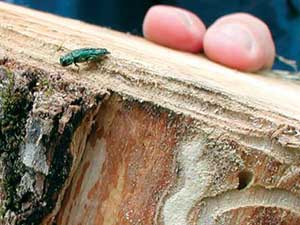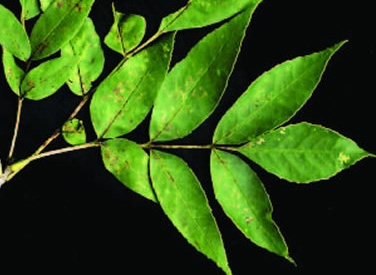 When is bad news good business? When it’s about the emerald ash borer and you’re in the tree business.
When is bad news good business? When it’s about the emerald ash borer and you’re in the tree business.
Billboards went up around the Twin Cities this week for eabexperts.com, which turns out to be Rainbow TreeCare, of Roseville and Minnetonka.
“When the news hit that it was in the Twin Cities, we actually had to bring on additional staff to help field the calls, primarily from our current clients but other people who are concerned about it,” Dr. John Lloyd, the science and research director for the firm, told me this afternoon. “It’s a double-edged sword. We’re in down economic times so anything that brings the value of trees to the forefront, it’s good from that perspective. But it’s not like all we’re doing is running around selling EAB treatments and saying ‘Yay!'” he said. “That’s not the gravy train. It’s not going to last.”
“Most of the discussion is first about whether the tree you have is actually an ash tree and then the issue is it is something that you want to invest into treating or is it something that if you’re going to lose it, let’s plan on planing something better.”
One client planted three ash trees last year. “I said, ‘that was not a good plan,'” said Lloyd, who doesn’t sound like much of an ash tree fan in the first place. “The trees do not have any form of genetic resistance to this pest, unlike the bronze birch borer which is a native pest to native trees, they actually have a resistance response to it. So if you keep the trees healthy, they can respond to it. With emerald ash borer, there’s no genetic resistance so no matter how healthy the tree is — how well watered it is — they can succumb to the emerald ash borer. So the first question is: Are you willing to invest to putting insecticide in the tree every year for the rest of its life?”
That’ll run you about $200 per tree. On the other hand, removing a tree can cost $1,000 and he says keeping the tree alive for a few years can give you time to put the money aside to take it down.
Should you cut down your ask now rather than wait? “It depends on the value of the tree in your landscape. If you’re asking yourself the question of whether it’s worth saving or not, to me it’s not worth it,” he said.
“And plant what?” I asked.
“I’m not normal,” Lloyd said. “Most people say ‘I want something that will grow and be a mature, large tree before I die.’ We have such a short lifespan compared to trees. I love oak trees. They have some health problems, but it’s something we can manage. The faster a tree grows, the poorer the form will be.”
Lloyd wasn’t always down on ash trees. “Back when I was the university, we recommended planting ash trees because they could survive urban stresses.”
Not all ashes are created equal in the eyes of the emerald ash borer, however. The mountain ash, Korean mountain ash, and European mountain ash are not susceptible to EAB. The white ash, a native tree in swampy areas up north, the American ash, and the black ash, however, are in trouble with the infestation.
With foliage on the tree, now is the time, Lloyd says, to identify what kind of ash tree you have. “Generally with ash you can have three and five leaves opposite each other whereas with a mountain ash you have many more than that and they’re much smaller.”
In other words, this is a bad ash tree to have:

This is a good one:

Here’s the company’s emerald ash borer fact sheet with more information. Here’s more EAB information from the University of Minnesota Extension Service.
